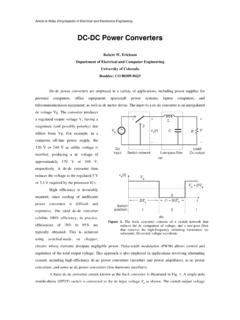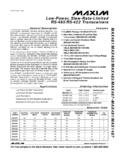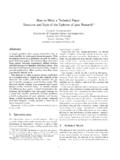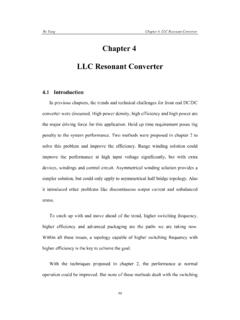Transcription of The Parallel Resonant Converter
1 CHAPTER 5 The Parallel Resonant Converterhe objective of this chapter is to describe the operation of the Parallel Resonant Converter indetail. The concepts developed in chapter 3 are used to derive closed-form solutions forthe output characteristics and steady-state control characteristics, to determine operating modeboundaries, and to find peak component stresses. General results are presented using frequencycontrol for both the continuous and the discontinuous conduction modes. This chapter alsoexplains the origin of the discontinuous conduction mode, which is in many ways the dual of theseries Resonant discontinuous conduction characteristics of the Parallel Resonant Converter are quite different from those of theseries Resonant Converter , and from those of conventional PWM converters.
2 The Parallel topologycan both step up and step down the dc voltage. Although the output characteristics are againelliptical, near resonance they exhibit a current-source characteristic. The discontinuousconduction mode occurs under heavy loading (or short-circuit conditions, in the limit). Thetransistor current stresses and conduction loss depend on the output voltage, and are nearlyindependent of load these features may make the Parallel Resonant Converter ill-suited to someconventional power supply applications, they can be used to advantage in others.
3 An example isgiven in section , in which the Parallel Resonant Converter is used to construct a 24V:10kV highvoltage power supply with current source characteristics. Design considerations are outlined, andthe near-ideal operation of an experimental circuit is described. A second application example isalso explored, in which the Parallel Resonant Converter is used as an off-line low harmonic Converter input characteristics are found, and the advantages and disadvantages of the PRC inthis application are of Resonant Power Conversion25 . 1 .Ideal S teady - S tate Characteris tics in the Co ntinuo us Conduction ModeA full bridge isolated version of the Parallel Resonant Converter is given in Fig.
4 Forthis discussion, a 1:1 turns ratio is assumed. The Converter differs from the series resonantconverter because it is the tank capacitor voltage, rather than the tank inductor current, which isrectified and filtered to produce the dc load voltage. A two-pole L-C low pass filter (LF and CF)performs this filter function. Hence, we haveV = <| vC |>(5-1)by use of the flux-linkage balance principle (Chapter 3) on inductor LF. The magnitude of thequasi-sinusoidal voltage vC(t) is controllable by variation of the switching frequency vCbecomes large in amplitude near resonance.
5 Hence, the dc output voltage V is controllable byvariation of the normalized switching frequency F = fS / : nD5D6D8D7V+ LFCFIIF+ vC vT+ iLRFig. bridge realization of the Parallel Resonant LF and CF filter elements are large , , their switching ripple components are smallcompared to their respective dc components in a well-designed Converter . Hence, IF and V areessentially dc. Also, by charge balance on CF, we have in steady-stateIF = I(5-2)Typical waveforms are drawn in Fig. for above-resonance operation with zero voltageswitching. The input bridge produces a square wave output voltage vT(t), which is applied acrossthe LC tank circuit.
6 In response, the tank current and tank capacitor voltage ring with quasi-sinusoidal voltages. The bridge rectifier now switches when the tank voltage passes through peak values of the tank waveforms vC(t) and iL(t) do not, in general, occur at the transistor orChapter 5, The Parallel Resonant Converter3diode switching times. In thecontinuous conduction mode, foursubintervals occur during eachswitching period. The circuittopologies during these subintervalsdepend on the conducting states ofthe input and output bridges, whichin turn depend on the input bridgedrive signal and the polarity of thetank capacitor tank circuits duringeach of the four subintervals aredrawn in Figs.
7 In eachcase, the tank circuit topology isidentical to that of Fig. ,repeated in Fig. The appliedtank voltage VT is Vg, dependingon the conducting states of the inputbridge switches, and the appliedtank current IT is IF (= I),depending on the polarity of thetank capacitor voltage. Thesevoltages are summarized in 5. 1. Applied tank voltages and currents for the Parallel res onant converteroperating in continuous conduction modeIntervalVTMTITJT1+Vg+1 I J2+Vg+1+I+J3 Vg 1+I+J4 Vg 1 I J 0tvT+Vg-VgiLIL1IL0 vC-IL0-VC0VC0|vC|-IL1V = <|vC|>Fig.
8 Waveforms for the Parallel resonantconverter operating in continuous conduction of Resonant Power Conversion4S tate p lane p o rtraitThe normalized state plane trajectory for thecircuit of Figs. and is derived in As before, the tank waveforms arenormalized according to the definitions mC(t) = vC(t) / Vg and jL(t) = iL(t) R0 / Vg. The result isplotted in Fig. and reproduced in Fig. The tank circuit solutions follow circular arcs,centered at the applied tank voltage and current values (mC, jL) = (MT, JT), and with radiusdependent on the initial values of mC and can now construct the state plane trajectory for a complete switching period in thecontinuous conduction mode.
9 As shown in Fig. , the trajectory begins at 0t = 0, at the initialpoint (mC(0),jL(0)) = ( MC0, JL0) for subinterval 1. The tank capacitor voltage must be negative(so that output diodes D6 and D7 conduct and the circuit of Fig. applies), and the tank inductor+ iL+ vC Vg I iT = I+ vT = +Vg < 0 Subinterval 1Q1, Q4, D6, D7 conductv < 00 < 0 t < CFig. circuit during subinterval 1.+ iL+ vC Vg I iT = +I+ vT = +Vg > 0 Subinterval 2Q1, Q4, D5, D8 conductv > 0C < 0 t < + = Fig. circuit during subinterval 2.+ iL+ vC Vg I iT = +I+ vT = Vg > 0 Subinterval 3Q2, Q3, D5, D8 conductv > 0C < 0 t < + Fig.
10 Circuit during subinterval 3.+ iL+ vC Vg I iT = I+ vT = Vg < 0 Subinterval 4Q2, Q3, D6, D7 conductv < 0C + < 0 t < 2 Fig. circuit during subinterval 4.+ iL+ vC iTvTLCFig. form of tank circuittopology .jLjL(0)mC(0)mCrrMTJTFig. plane trajectory, for thecircuit of Fig. 5, The Parallel Resonant Converter5current is also drawn initiallynegative for this example. FromTable and Fig. , thenormalized state plane trajectoryfollows a circular arc centered at(mC, jL) = (+1, J). The radiusof this arc r1 is the distancebetween the initial point and thecenter, and remains constant.











